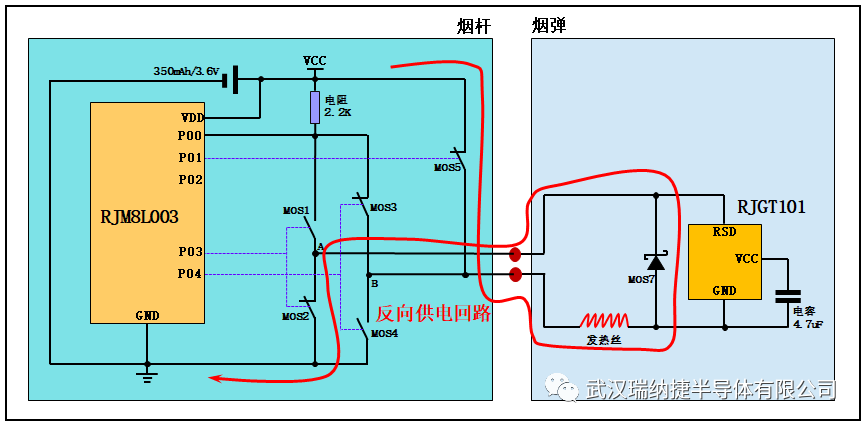The traditional electronic cigarette cartridge has only two contacts connected to the cigarette rod in structural design. The main board circuit of the cigarette rod provides driving current to the heating wire of the cartridge through these two contacts to heat the e-liquid to achieve the effect of atomization.
In order to prevent pirated pods from harming the interests of brands and users, it has become the consensus of brand merchants to add identifiable encryption chips to pods, but the question is how to add circuit boards and readout interfaces to small and precise pods?
Not changing the appearance of the cartridge, nor affecting the normal operation of the atomization chamber and airflow channel, has become the design appeal pursued by all engineers!
The RJGT101D6 encryption chip launched by Renage Semiconductor is a single-bus chip that provides power and data through the 1-Wire bus. The host system only needs to connect RSD (single bus) and GND (ground) to perform two-way interactive authentication with RJGT101D6.
This means that it is possible to use the two contacts of the existing pod to connect the RJGT101D6 to realize data communication and power transmission with the pod host, without adding contacts and changing the appearance of the pod!
After multiple demonstrations and repeated tests by Renatech engineers, a low-cost feasible solution was finally developed. The measured solution has the following characteristics:
1. There is no need to change the appearance of the traditional two-contact cartridge (no additional contacts, no change of airway).
2. There is no need for mechanical foolproofing, and the cigarette rod host can automatically identify the forward and reverse insertion of the pod.
3. The cigarette stick host and the pod encryption chip can have two-way data interaction and two-way identity authentication.
4. The work of the heating wire of the pod atomizer and the work of the encryption chip do not affect each other.
5. The cost of the solution is low, only 7 ordinary MOS tubes are needed for the main body of the pod, and only 1 ordinary MOS tube is needed in the cartridge.

Figure 1 Prototype of the positive plug-in circuit of the pod
The prototype of the positive plug-in circuit of the cartridge in this scheme is shown in Figure 1.
Because the heating wire in the pod has no polarity, and the encryption chip RJGT101D6 has polarity, the core problem to be solved on the pod side is the detection of the polarity of the pod and the switching of the power supply direction. This solution uses NMOS tubes and PMOS tubes. A switch circuit is formed to switch the power supply direction of the pod to realize that the pod can be plugged in both forward and reverse directions.
On the other hand, the heating wire inside the pod and the encryption chip RJGT101D6 can only be connected in series or in parallel. How to make them not affect each other’s work is the difficulty of pod circuit design.
This solution uses RJGT101D6 and heating wire in series, because the encryption chip RJGT101D6 must apply forward voltage (RSD pin is connected to high level, GND pin is connected to low level) to work and communicate. We connect the RSD pin and GND pin of RJGT101D6 between the pin A unidirectional PMOS tube is connected in parallel (similar to the role of a diode), and this PMOS tube acts as a reverse bypass of the RJGT101D6.

Figure 2 Forward power supply loop
As shown in Figure 2, when the cigarette rod host provides a forward voltage to the pod, both the encryption chip and the heating wire can work. However, the working current of the encryption chip RJGT101D6 is very small (less than 1mA), so when the cigarette rod is powered forward, although a current of 1mA passes through the heating wire, it hardly generates heat and will not cause atomization.
As can be seen from the forward power supply loop in Figure 2, the RJGT101 is powered by a 2.2K pull-up resistor through MOS1, and finally returns to the power ground through MOS4.

Figure 3 Reverse power supply circuit
As shown in Figure 3, when the cigarette rod host provides reverse voltage to the pod, the RJGT101D6 is bypassed by the PMOS tube, and only the heating wire can work. When the heating wire is working, it is necessary to open MOS1 and close MOS2, open MOS4 and close MOS3, and the battery outputs the maximum power through MOS5 to drive the heating wire to generate heat.

Figure 4 The prototype of the smoke bomb anti-insertion circuit
Let’s analyze how the cigarette rod circuit works when the pod is inserted back. As can be seen from Figure 4, it is only necessary to open MOS1 to close MOS2, close MOS3 and open MOS4 to provide the forward working voltage for the RJGT101.
When the heating wire is working, it needs to open MOS2 and close MOS1, open MOS3 and close MOS4, and the battery provides high-power driving current for the heating wire through MO6, and then returns to the ground through MOS4.
China Electronic Cigarette Factory/ The best electronic cigarette factory in China/Cheap vape /vape pen/ vape pod/ .The New vape /vape pen/ vape pod/ Popular/fashionable/prevalent vape /vape pen/ vape pod/No leakage/ No leak vape /vape pen/ vape pod/ delicious flavor vape /vape pen/ vape pod/ vape /vape pen/ vape pod/ Wholesaler/vape /vape pen/ vape pod/ manufacturers/ vape /vape pen/ vape pod/ suppliers/ vape /vape pen/ vape pod/ actory、Customized/vape /vape pen/ vape pod/ Free Sample/vape /vape pen/ vape pod/ buy discount/ vape /vape pen/ vape pod/ quotation/Top vape /vape pen/ vape pod/ Best vape /vape pen/ vape pod/ vape /vape pen/ vape pod/ in stock/ vape /vape pen/ vape pod/ near me